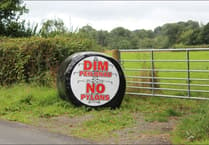AS A name, this isn’t one to set the Ystwyth on fire . The Independent Remuneration Panel for Wales sounds so boring people may not inquire further.
But hold on. Because this little lot are costing us quite a lot of money.
Its five Welsh government-appointed members are charged with recommending how much county councillors should get paid.
At the moment, it’s not fit to to do any such job because it patently hasn’t the foggiest idea about the hardships of life in the country’s low-wage economies, and the ways in which the poor are feeling the repercussions of the squeeze on local government budgets, added to by a marked lack of lateral thinking by councils themselves.
From this month, this august and remote body says, those nodding puppets of the council chamber - yes, of course there are laudable exceptions - should get £18,666 a year - a 6.04 per cent rise.
Leaders and deputy leaders and cabinet members naturally get more. Ceredigion council leader Bryan Davies, building on last year’s £2,250 pay rise, now receives another £3,398, taking his salary to £59,498.
How dizzyingly generous is all this - considering the current UK inflation rate is just 3.40 per cent. Bit of a difference, eh?
And of course, in Ceredigion at least, members of the county council, confronted by this largesse, did, as usual, what was expected of them, waving the recommendation through, without demur.
Challenge them, and they would be virtually guaranteed to tell you, in tones of injured innocence: “Look, this is nothing to do with us. This is an independent body. We haven’t got any say over what they recommend.”
Which is true. But it is also true that there is no obligation to take the money, and in this most difficult of years you may think that they would choose to show empathy with struggling members of the public and decline any pay increase at all, let alone this highly inflationary one.
So what well-heeled fantasy world does this remuneration panel inhabit? Certainly, it is one in which prosperity and comfortable living will be taken for granted. Unlike, that is, the pinched worlds of the in-work poor of Wales, who will foot the bill not only for the newly-enriched members of Welsh county councils but the fees of their ‘independent’ benefactors. (The panel members get £282 a day, which works out much the same as low-paid workers in rural Wales get in a week.)
And by what labyrinthine method of calculation did the panel arrive at their 6.04 per cent figure?
Perhaps they simply took turns at throwing the dice which, with irresistible regularity, kept on coming up with sixes.
Or perhaps, because they themselves get the full-time equivalent of £101,520 a year, anything less would have seemed like a flick in the face with an out of date banknote.
Without exception, all the panel members have had senior managerial jobs in the public and private sectors. Presumably, they are all comfortably off. Their failure is their apparent total inability to understand the daily privations of those who aren’t.
The appalling treatment of our junior doctors
IN PRINCIPLE, pretty well everyone is a fan of the NHS.
Apart from a bit of grousing from time to time, there’s no argument generally about its status as a bedrock institution we couldn’t do without.
But how much of this supposed affection is mere sentimentality, and to what extent is our fondness no more than skin-deep?
During the pandemic, there was no shortage of dewy-eyed expressions of gratitude for the very real selflessness and devotion of doctors and nurses who laid their lives on the line to keep patients from death’s door.
A few years later, and the cheers on the doorsteps and the gushing praise have all. But evaporated. Gone, it seemed, was the citizen solidarity with the pay-and-conditions struggles of nurses and junior doctors.
Last September, after a long and bitter battle with a stubbornly unhelpful Welsh government, nurses finally won a very modest five per cent pay increase and a one-off payment for 2022-23 worth between £900 and £1,190. There was also agreement on flexible working, staffing rotas and a government commitment to explore the possibility of a 36-hour working week with no pay reduction.
Credit for this victory went solely to a determined Royal College of Nursing. Public support? Not much, beyond the gesture of supportive tooting as cars passed picket-lines.
But the struggles of junior doctors - equally a backbone of the NHS - continue, again with scant visible backing from a supposedly supportive public. Who noticed that they were forced by an inexcusably stonewalling government into a 72-hour strike in February, and another - for 96 hours - last month. Who noticed, and who cared?
The public’s near-desertion of nurses and doctors in their hour of need contrasts horribly with their devotion to the public - and that not only during Covid.
The utter reasonableness of the Wales British Medical Association’s position should be more than enough to galvanise a sleeping public.
Dr Oba Babs-Osibodu and Dr Peter Fahey, co-chairs of its junior doctors committee, point out: “We aren’t asking for a pay rise - we are asking for our pay to be restored in line with inflation back to 2008 levels, when we began to receive pay cuts in real terms. Pay needs to be fair and competitive with other healthcare systems across the world to retain and recruit doctors.”
Which it isn’t, as this column has repeated stressed, junior doctor pay in Wales being a miserly fraction of what such medics get paid in other parts of Europe, let alone in countries including Australia and New Zealand, to where, seeing no alternative, a steady stream of UK doctors are going.
We ignore the junior doctors’ plight at our peril. Fail to stick up for them, and one day they may not be there.
Consider equally the injustice of the matter. A doctor starting their career in Wales will earn as little as £13.65 an hour, and for that they could well be performing lifesaving procedures and taking on huge levels of responsibility.
Wake up, Wales!
Why we have to stop arms sales to Israel
THE hypocrisy is stunning.
More than 30,000 Palestinians have been killed in the six months since the hideous Hamas assault last October.
Governments wring their hands at this appalling bloodshed. Including Joe Biden. Yet, according to The Washington Post and Reuters, America has authorised arms transfers to its ally worth billions of dollars.
These include more than 1,800 MK84 2,000lb bombs and 500 MK82 500lb bombs, as well as 25 F35A fighter-jets.The larger bombs have previously been linked to air-strikes in Gaza, causing mass casualties.
According to the Stockholm International Peace Research Institute (SIPRI), the US accounted for 69 per cent of Israel's arms imports between 2019 and 2023. Other major arms suppliers are Germany and Italy.
The UK's arms exports to Israel are “relatively small”, according to the British government, amounting to £42m in 2022.
The Campaign Against Arms Trade (CAAT) notes that, since 2008, the UK has granted arms export licences to Israel worth £574m in total. Much of those are for components used in US-made warplanes that end up in Israel. But the British government is rightly coming under growing pressure to suspend those exports.
Calls for a ban on arms exports to Israel are finally gathering pace. But it has taken the dreadful killing of seven aid-workers in a strike by the Israeli Defense Forces to concentrate minds following month after month of catastrophe on the ground in Gaza.





Comments
This article has no comments yet. Be the first to leave a comment.